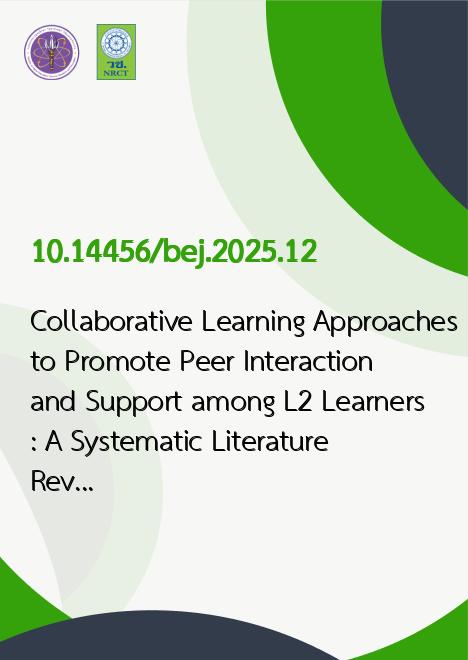
|
Collaborative Learning Approaches to Promote Peer Interaction and Support among L2 Learners: A Systematic Literature Review |
|---|---|
| รหัสดีโอไอ | |
| Creator | Bryan D. Lopez |
| Title | Collaborative Learning Approaches to Promote Peer Interaction and Support among L2 Learners: A Systematic Literature Review |
| Contributor | Michael L. Estremera |
| Publisher | Ph.D. Program in English Language Teaching (ELT), Faculty of Humanities and Social Sciences, Buriram Rajabhat University |
| Publication Year | 2568 |
| Journal Title | BRU ELT JOURNAL |
| Journal Vol. | 3 |
| Journal No. | 2 |
| Page no. | 174-186 |
| Keyword | cooperative learning approaches, collaborative learning approaches, literacy, peer interaction, PRISMA, systematic literature review |
| URL Website | https://so14.tci-thaijo.org/index.php/bru_elt_journal/index |
| Website title | https://so14.tci-thaijo.org/index.php/bru_elt_journal/article/view/1659 |
| ISSN | 2822-1311 |
| Abstract | Collaborative learning examines the role and effectiveness strategies in fostering peer interaction and supporting literacy development among second language (L2) learners. Drawing on 24 peer-reviewed empirical studies published between 1992 and 2021, this review synthesizes findings from diverse educational contexts across North America, Asia, and Europe. The review was conducted using a rigorous methodological protocol, including defined inclusion/exclusion criteria, structured database searches (Scopus, ERIC, and Google Scholar). Key cooperative learning approaches investigated include jigsaw, think-pair-share, peer feedback, and collaborative writing tasks. The findings indicate that cooperative learning significantly enhances peer interaction by promoting language-related episodes (LREs), negotiation of meaning, and mutual scaffolding, all of which contribute to improved engagement and language output. Furthermore, these strategies have been linked to gains in literacy-related outcomes such as reading comprehension, vocabulary development, and writing fluency. The review also highlights positive socio-cultural concepts, including increased learner confidence, motivation, and classroom participation. However, challenges such as proficiency imbalances, uneven group dynamics, and the need for teacher facilitation persist. Hence, collaborative learning serves as an umbrella term encompassing various group-based learning approaches, this systematic literature review specifically focuses on cooperative learning due to its structured nature and well-defined theoretical underpinnings. Cooperative learning is characterized by positive interdependence, individual accountability, face-to-face promotive interaction, social skills development, and group processing (Johnson & Johnson, 1999). These core elements differentiate it from more loosely organized collaborative strategies such as unstructured group discussions. In this review, approaches like Think-Pair-Share, Jigsaw, Reciprocal Teaching, Peer Review, and Collaborative Writing are included under the cooperative learning framework because they are implemented with clearly assigned roles, shared goals, and structured interaction sequences designed to ensure accountability and peer support. On the other hand, general group discussions that lack these formal components are intentionally excluded, as they do not consistently meet the criteria for cooperative learning. This distinction allows for a more focused analysis of how intentionally designed cooperative structures influence L2 learners’ engagement and literacy outcomes, compared to broader and less systematic forms of peer interaction. |